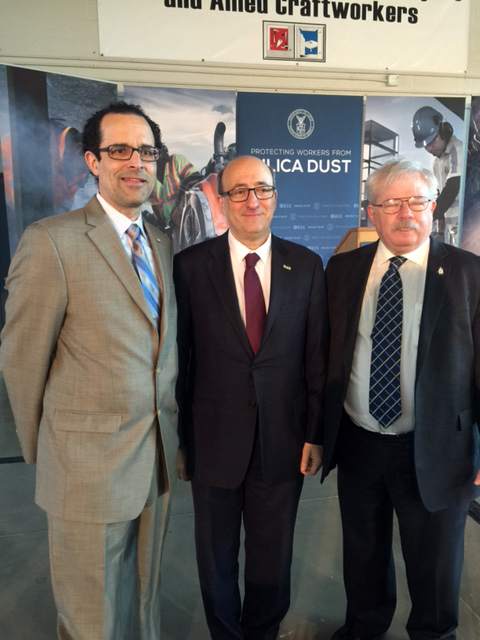(Pittsburgh, March 24, 2016) - The U.S. Occupational Safety and Health Administration (OSHA) today issued long-awaited final rules sought by the USW to protect workers from the deadly dangers of silica dust.
The new rules, the first update to regulations governing silica dust in four decades, are expected to curb lung cancer, silicosis, chronic obstructive pulmonary disease and kidney disease.
To the right is: Alan White, USW Local 593
member (left); Dr. David Michaels,
OSHA Assistant Secretary (center);
Mike Wright, Director, USW Health,
Safety & Environment Dept. (right).
“This rule will save lives. It will enable workers to earn a living without sacrificing their health,” U.S. Labor Secretary Thomas Perez announced at a press conference in Bowie, Md.
About 2.3 million men and women face exposure to respirable crystalline silica in their workplaces, including two million construction workers who drill and cut silica-containing materials such as concrete and stone, and 300,000 workers in operations such as brick manufacturing, foundries and hydraulic fracturing.
Most employers can limit harmful dust exposure by using equipment that is widely available – generally using water to keep dust from getting into the air or a ventilation system to capture dust where it is created.
More than 80 years ago, Labor Secretary Frances Perkins identified silica dust as a deadly hazard and called on employers to fully protect workers, Perez added.
He said the new rule “builds upon decades of research and a lengthy stakeholder engagement process, including the consideration of thousands of public comments, to finally give workers the kind of protection they deserve and that Frances Perkins had hoped for them.”
According to OSHA, some 1.7 million American workers are regularly exposed to silica dust on the job. The agency believes the new rules could save as many as 700 lives and prevent 1,600 new cases of silicosis each year.
The final rule is written as two standards, one for the construction industry and one for general industry and maritime workers.
The new standards will reduce the permissible exposure limit and require employers to use improved work practices, such as limiting access to high exposure areas, and engineering controls such as water or ventilation. Training and medical exams for highly exposed workers will be required.
Employers covered by the construction standard have until June 23, 2017, to comply with most standards. Employers covered by the general industry and maritime standard have until June 23, 2018, to comply with most requirements. Additional time is provided to offer medical exams to some workers and for hydraulic fracturing employers to install dust controls and meet the new exposure limit.
The USW has for decades been pushing for new standards to protect its members from exposure to silica. The most severe exposure for USW members occurs in metal making and foundries, oil and gas drilling, cement production, brick, glass and asphalt manufacturing, china and ceramic manufacturing, ship building, and the tool and die industry.
USW Local 593 member Alan White contracted silicosis several years ago from working at a copper mill in Buffalo, N.Y., and has many times testified in Washington, D.C. encouraging updated standards.
| The Human Cost of Silicosis: Secretary Tom Perez and Alan White In early March, Steelworker Alan White met with U.S. Secretary of Labor Thomas E. Perez to discuss the disease’s impact on his life. Click here to listen to the interview. |

